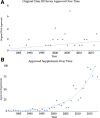Postmarket Modifications of High-risk Plastic Surgery Devices
- PMID: 32309074
- PMCID: PMC7159931
- DOI: 10.1097/GOX.0000000000002621
Postmarket Modifications of High-risk Plastic Surgery Devices
Abstract
Background: In the United States, high-risk medical devices must be cleared through the premarket approval (PMA) pathway, which requires clinical evidence ensuring safety and efficacy. Approved devices can be modified and reintroduced to market without additional study through the PMA supplemental review track. This study characterizes the changes of high-risk plastic surgery devices once they undergo initial clearance.
Methods: A retrospective, cross-sectional analysis of the Food and Drug Administration (FDA) PMA database. The following data were extracted from the PMA database (January 1, 1980 to December 31, 2018): initial clearance date, device type, the number and type of supplement, supplement reason, and product withdrawal date. Data from the FDA medical device recall database were also extracted and reported. The median number of device modifications and median lifetime of device-years were calculated.
Results: There have been 39 original plastic surgery devices approved by the FDA. There was no significant change with respect to initial clearance dates for original devices over time (r = 0.28; P = 0.084). PMA supplement usage has significantly increased with time (rs = 0.9174, P = 0.000). Overall, approved plastic surgery devices have undergone a median of 11 changes (IQR, 3-35). Breast implant devices collectively underwent the most modifications with a median of 28 modifications per device (IQR, 20.25-33.25).
Conclusions: Over the past 2 decades, plastic surgery device manufacturers have significantly increased the use of supplement track review. High-risk plastic surgery devices may undergo frequent minor changes without clinical evidence to support the safety and efficacy of modified versions.
Copyright © 2020 The Authors. Published by Wolters Kluwer Health, Inc. on behalf of The American Society of Plastic Surgeons.
Figures
Similar articles
-
How do Orthopaedic Devices Change After Their Initial FDA Premarket Approval?Clin Orthop Relat Res. 2016 Apr;474(4):1053-68. doi: 10.1007/s11999-015-4634-x. Epub 2015 Nov 19. Clin Orthop Relat Res. 2016. PMID: 26584802 Free PMC article.
-
Incremental Revisions across the Life Span of Ophthalmic Devices after Initial Food and Drug Administration Premarket Approval, 1979-2015.Ophthalmology. 2017 Aug;124(8):1237-1246. doi: 10.1016/j.ophtha.2017.03.040. Epub 2017 May 10. Ophthalmology. 2017. PMID: 28501378
-
Postmarket Modifications of High-Risk Therapeutic Devices in Otolaryngology Cleared by the US Food and Drug Administration.Otolaryngol Head Neck Surg. 2015 Sep;153(3):400-8. doi: 10.1177/0194599815587508. Epub 2015 Jun 4. Otolaryngol Head Neck Surg. 2015. PMID: 26044785
-
Analysis of FDA-Approved Orthopaedic Devices and Their Recalls.J Bone Joint Surg Am. 2016 Mar 16;98(6):517-24. doi: 10.2106/JBJS.15.00286. J Bone Joint Surg Am. 2016. PMID: 26984921 Review.
-
Public Health Effectiveness of the FDA 510(k) Clearance Process: Measuring Postmarket Performance and Other Select Topics: Workshop Report.Washington (DC): National Academies Press (US); 2011. Washington (DC): National Academies Press (US); 2011. PMID: 24983054 Free Books & Documents. Review.
Cited by
-
Development of a conceptual framework for reporting modifications in surgical innovation: scoping review.BJS Open. 2023 Mar 7;7(2):zrad020. doi: 10.1093/bjsopen/zrad020. BJS Open. 2023. PMID: 37104755 Free PMC article.
References
-
- Medical devices 2030. https://advisory.kpmg.us/articles/2018/medical-devices-2030.html. Accessed March 29, 2019.
-
- U.S. Department of Health and Human Services. Regulated Products – Medical Device Overview. https://www.fda.gov/forindustry/importprogram/importbasics/regulatedprod.... Accessed April 14, 2019.
-
- Faris O, Shuren J. An FDA viewpoint on unique considerations for medical-device clinical trials. N Engl J Med. 2017;376:1350–1357. - PubMed
LinkOut - more resources
Full Text Sources
Miscellaneous



